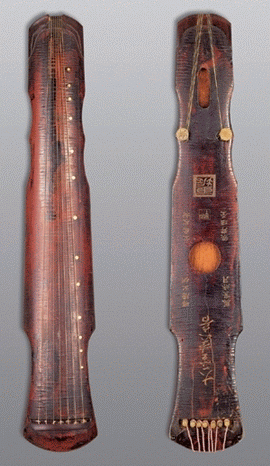 |
||||||||
GuQin |
||||||||
 |
The guqin, is a fretless seven-stringed zither, and is
China's oldest stringed instrument, with a history of some 7, 000 years.
Historically, the guqin has been viewed as a symbol of Chinese high culture,
but today only a few thousand people can play it, and it is rarely seen
in China. It is also a very quiet instrument, and suited to solo performances,
or sometimes played in concert with a few other compatible instruments,
or accompanied by voice. The guqin is a unique instrument which needs to be hand made by specialist craftsmen using special wood, lacquer and a high degree of skill. Most guqin's sold in general music stores, even in China, are virtually unplayable and are suitable only for hanging on the wall for decoration. Professional qin players never buy such instruments or recommend them to their students. Not only are they unable to produce an acceptable sound, they can even cause injury to a student's hand. Whilst traditionally the instrument is known simply as the 'Qin', this name came to mean a wide variety of instruments, so for clarification during the 12th Century, the prefix 'Gu' was added. 'Gu' means ancient, whilst 'Qin' means stringed instrument Around this time a standard format was also introduced, which gave basic dimensions and set the number of strings at 7. Traditionally the GuQin had 5-strings. Records relate of ancient 12 stringed versions, and a 10-stringed one was unearthed in the 1970's. There also exists a full written description of a single stringed version. Today GuQin specifically means a fretless 7-stringed zither about 4-feet long, which lays flat and is played in similar fashion to an Hawaiian guitar, although its pitch is much lower Until the Cultural Revolution, all strings were made of silk. Since then nylon or flatwound steel strings, which offer greater loudness and durability Based upon information supplied by Wikipedia. For full description see: http://en.wikipedia.org/wiki/Guqin Related Instruments: 1. Japanese 'ichigenkin', which is thought to be derived from the GuQin 2. Korean 'geomungo' 3. Chinese 'zhu', similar but plucked with a stick Chinese 'guzheng', a very similar instrument also with 7 fretless strings, but with moveable bridges under each string |
|||||||
|
||||||||